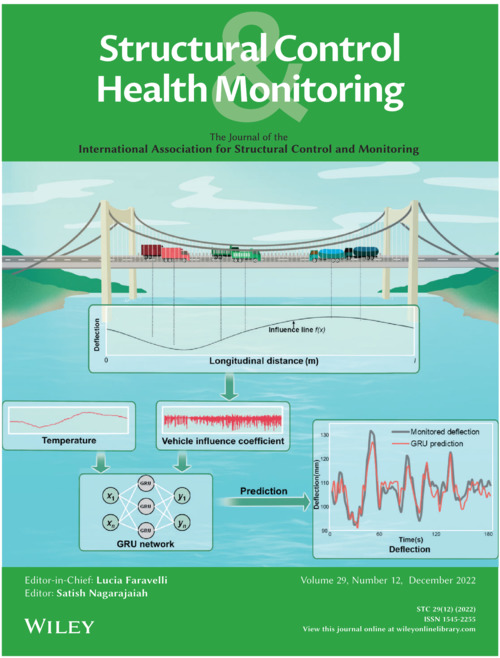工业厂房移动车辆地面工具平台的主动微振动控制
IF 5.4
2区 工程技术
引用次数: 0
摘要
高柔性工具(或设备)平台在平台底部受到地板激励时的振动响应比矮柔性工具(或设备)平台的振动响应更为关键。本研究在液晶显示器(LCD)制造工厂(fabs)中测试了所提出的用于高层平台的主动压电质量阻尼器(APMD)或驱动器在内部自动引导车辆(AGV)诱导的更大强度和更宽带宽的地板振动下的微振动控制性能。与传统的主动调谐质量阻尼器(atmd)不同,APMD不需要辅助弹簧和阻尼元件来调节固有频率和减小质量块的冲程。推导了AGV运动力作用下的连续三跨梁(或楼板)系统和主动控制工具平台的运动方程。APMD由压电堆和质量块组成,安装在平台上,受基座旋转激励,这可能归因于agv引起的不均匀垂直地板振动。采用直接输出反馈控制算法确定最优反馈增益矩阵,计算主动控制力。对连续梁-平台模型在不同AGV权值相同速度下进行时程分析,并通过三倍频带频谱分析得到相应的楼板和平台速度振动谱。数值模拟结果表明,与AGV重量无关,无APMD平台微振动普遍超过VC-A级。在安装了APMD后,平台的微振动显著降低了90%以上,振动达到了预期的振动极限(VC-B)。此外,APMD具有与ATMD相当的微振动控制性能,并且在相同的主动控制力下需要更少的质量块、冲程和施加电压。在现实生活中的高科技生产工厂中,agv引起的平台微振动一直在发生;因此,所提出的低功耗APMD是一种经济可行的方法,可用于LCD晶圆厂高平台的持续微振动控制。本文章由计算机程序翻译,如有差异,请以英文原文为准。
Active Microvibration Control of Tool Platforms Installed on the Floors Subjected to Moving Vehicles in Industrial Factories
The vibration responses of tall flexible tool (or equipment) platforms subjected to floor excitations at the platform base are considered more crucial than those of the short ones. This study examined the microvibration control performance of the proposed active piezoelectric mass damper (APMD) or driver for tall platforms subjected to internal automated guided vehicle- (AGV-) induced floor vibrations with larger intensity and broader bandwidth in liquid-crystal-display (LCD) fabrication factories (fabs). The APMD did not require auxiliary spring and damping elements to tune the natural frequency and reduce the stroke of the mass block as required by typical active tuned mass dampers (ATMDs). The motion equation of the proposed analytical model including a continuous three-span beam (or floor) system and an active-controlled tool platform under the action of the AGV moving forces was derived. The APMD, consisting of piezoelectric stacks and a mass block, was installed on the platform subjected to the base rotation excitation, which could be attributed to the uneven vertical floor vibrations induced by AGVs. Moreover, the direct output feedback control algorithm was adopted to determine the optimal feedback gain matrix for calculating the active control force. Time history analyses of the continuous beam-platform model under different AGV weights moving at the same speed were performed, and the corresponding velocity vibration spectra of the floor and platform were further obtained through one-third octave band spectrum analysis. Numerical simulation results revealed that the microvibrations of the platform without APMD generally exceed the VC-A level regardless of the AGV weight. Significant reductions of over 90% on the platform microvibrations could be achieved after the platform was implemented with the APMD, and vibrations met the desired vibration limit (VC-B). Moreover, the APMD exhibits comparable microvibration control performance to the ATMD and requires less mass of the mass block, stroke, and applied voltage under the same active control force. In real-life high-tech production fabs, AGV-induced platform microvibrations occur all the time; therefore, the proposed APMD with less power consumption could be an economical and feasible approach for persistent microvibration control of tall platforms in LCD fabs.
求助全文
通过发布文献求助,成功后即可免费获取论文全文。
去求助
来源期刊

Structural Control & Health Monitoring
Engineering-Building and Construction
自引率
13.00%
发文量
0
期刊介绍:
The Journal Structural Control and Health Monitoring encompasses all theoretical and technological aspects of structural control, structural health monitoring theory and smart materials and structures. The journal focuses on aerospace, civil, infrastructure and mechanical engineering applications.
Original contributions based on analytical, computational and experimental methods are solicited in three main areas: monitoring, control, and smart materials and structures, covering subjects such as system identification, health monitoring, health diagnostics, multi-functional materials, signal processing, sensor technology, passive, active and semi active control schemes and implementations, shape memory alloys, piezoelectrics and mechatronics.
Also of interest are actuator design, dynamic systems, dynamic stability, artificial intelligence tools, data acquisition, wireless communications, measurements, MEMS/NEMS sensors for local damage detection, optical fibre sensors for health monitoring, remote control of monitoring systems, sensor-logger combinations for mobile applications, corrosion sensors, scour indicators and experimental techniques.
 求助内容:
求助内容: 应助结果提醒方式:
应助结果提醒方式:


